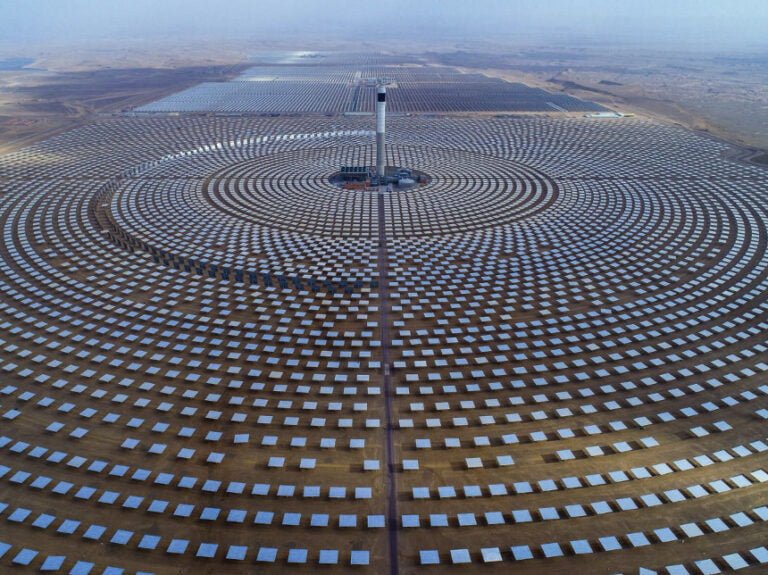We will look into the best 3 types of renewable energy in this article starting with Concentrared solar power. We will aslo cover two promising renewable energy systems called gasification of biomass & green hydrogen.
What is ‘Renewable Energy Technology’, and why is it important?
You casn use the term ‘Renewable Energy’ to describe energy produced using an infinite source. The types of renewable energy systems currently available are:
- Solar power – Using sunlight to create power with solar panels.
- Wind Energy – Utilises the planet’s wind via propellers and turbines.
- Biomass – Using animal and agricultural waste to produce power.
- Hydrogen – Using Hydrogen as a fuel source whose only waste product is water.
- Geothermal – Using hot springs and the Earth’s mantle to generate power
- Hydropower – Using a rivers flow to power turbines (without a dam)
- Marine Energy – Harness the power of the sea using the natural movement of the waves & tides.
Why do we need 100% renewable energy?
The fact is, for humans to continue progressing, we need renewable energy. As we have evolved, so has our use of technology. More technology means more energy, as a result we are at a point in the human story where our energy demand has outgrown the capabilities of fossil fuels.
Using fossil fuels is leading to irreversible damage to our planet’s ecosystems albeit hese ecosystems are necessary to sustain life on Earth and avoid catastrophic events. With the scientific breakthroughs and innovations available today, there is no reason for people to rely on the outdated and scientifically flawed use of fossil fuels.
We are not saving the planet. We are saving ourselves and many other life forms we share the Earth with. The planet has a history of recovery from catastrophic events.
What are the five benefits of renewable energy?
There are more than five benefits of using renewable energy technologies, too many to mention and cover in this article. There are enough benefits from renewable energy systems to write an entire essay, let alone a blog post.
So, what are the main five benefits of renewable energy systems?
- They are renewable – Energy derived from non-renewable energy sources is finite and will run out sooner rather than later. Switching to renewable energy creates a sustainable source of clean electricity to run your devices.
- Less pollution – Renewable power technologies create less harmful emissions and produce little to no contaminated waste products that contribute to global warming and public health issues.
- Employment – Green energy technologies require more humans to manage them., secondly fossil fuel extraction is expensive. Machinery and rigs perform much of the labour in contrast renewable energy technology means more jobs for the people.
- Cost – Although renewable energy facilities are expensive to set up, once running, they are more cost-effective to maintain than non renewables, which reduces the cost of renewable electricity per unit to the end user. Renewable energy is also accessible in abundance, which creates stable energy prices.
- Water – Nuclear power, gas, and coal power plants use water to cool down machinery during production. With communities and ecosystems already suffering from water diversion, extracting more fossil fuels will cause more damage.
It is also important to note that in the event of drought, which will increase due to global warming, nuclear, coal or gas plants will not be able to produce electricity ude to lack of water. Thanks to modular design, renewable energy technologies have shown resilience during extreme weather events.
Top 3 different types of renewable energy
Welcome to the future of renewable energy, where fossil fuels are a thing of the past! Renewable energy technology has come a long way in the past ten years also bringing new and ecologically sound ways to generate power.
At the Backyard Farmer, we believe in a future where modern life fits in with our planet. Becoming eco-friendly no longer means living in a yurt with no electricity. Lets cover the best 3 types of renewable energy.
1. Concentrated Solar Power (CSP)
What is concentrated solar power? Concentrated solar power is a relatively new solar technology which uses similar principles to traditional solar power but in a different way.
Many types of CSP technology use different ways of harvesting sunlight. You can use CSP towers, dishes, linear mirrors and parabolic trough systems, albeit they use the same theory and process. Each CSP technology takes sunlight and reflects it to a focus point to create heat & steam used to power generators.
How does CSP work?
Today we will look at one of the biggest CSP sites in the world, Noor Complex Solar Power Plant, Morocco. Rather than solar panels, a CSP system like this uses mirrors to reflect the sun’s rays to a focus point. This focus point is called the CSP Tower and is often referred to as a ‘Second sun’ due to the intense light reflecting from it.
How Concentrated Solar Power creates power
- Mirrors reflect the sunlight onto the CSP Tower.
- The concentrated solar rays heat a central receiver that can reach 600c.
- A pump then sends a medium like oil or molten salt to the heat collector, where the salt absorbs the heat which then makes its way to the storage tanks.
- The tanks then heat water to create steam, turning the power-generating turbines which create electricity.
How much power can Concentrated solar power create?
China’s first 100 MW solar matrix in Dunhuang can produce 2 million KWh daily in optimum conditions. There are some requirements for CSP to work, such as long durations of annual sunshine, adequate solar irradiance & a water source. The Southwest of the USA is also a great place to run CSP technology due to its sunny skies and hot temperatures.
2. Gasification of Biomass
How does the Gasification of Biomass work?
Next in the best 3 types of renewable energy is the Gasification of biomass. This is a process that has been in practice for a while now & is known as a mature technology. Manufacturers have a leg up in the field as biomass gasification is an established technology, unlike many emerging renewable energy systems.
To make Gasification a viable contender for renewable energy, companies only had to improve the already established processes. The technology can create a renewable energy source by using more sustainable energy sources to complete the gasification process.
Different gasifier technologies can produce CO2 & Hydrogen from biomass. However, most companies use ‘Updraft Gasifiers’.
How does the Gasification of Biomass create power?
The Gasification of biomass is the process of extracting valuable fuels from otherwise useless biowaste like corn stover or wheat straw. Other waste products that can be used include forest residues, crops like switchgrass or willow trees grown for energy use, organic domestic solid waste, and animal waste.
What gases does the Gasification of biomass create?
The Gasification of biomass creates many gases, all of which have their application. Biomass creates the following products used for renewable energy systems:
- Hydrogen
- Carbon monoxide
- Carbon Dioxide
You can create biofuels from hydrogren, carbon monoxied & carbon dioxide through biochemical and thermochemical processes.
How much power can the Gasification of Biomass create?
The amount of energy a biomass gasification plant can produce depends on the size of the plant and the technology used. The largest biomass gasification plant in Valmet Gasifier, Vaskiluodon Voima Oy, Vaasa, Finland, has a 140 MW capacity.
Other biomass power plants produce:
- 20 MW in Gothenburg, Sweden
- 110 MW in OKI Pulp & Paper Mills, Indonesia
- 87 MW in Bioproduct Mill, Äänekoski, Finland
- 50 MW Chenming Pulp Mill, Huanggang, China
What I like about Gasification of Biomass technology
- Carbon-neutral technology requires the extraction of CO2 from the atmosphere to process biomass into fuel, presently ecycling CO2 is one way to offset your carbon footprint.
- Reduces methane levels, biomass Gasification uses animal and agriculture waste to create power whereas if left these wastes can emit large amounts of methane, a greenhouse gas.
- Low-cost resource, animal and agriculture waste is abundant in first and third-world countries. Therefore, it can be used as a cheap and renewable energy source.
What I dislike about Gasification of Biomass technology
- It is yet to be 100% renewable due to cryogenic processes required to separate oxygen from the air, which is an energy-intensive process with a large carbon footprint and contributes significantly to global warming.
- Biomass feedstock production is the process by which a biomass gasification plant may obtain some of its fuel. The process could be more environmentally friendly due to soil disturbance, nutrient depletion and impaired water quality.
- In extensive facilities, biomass gasification requires using large land areas to build on, leading to habitat loss and environmental damage.
3. Green Hydrogen (Renewable Hydrogen)
Hydrogen is a promising technology that can replace non-renewables in areas that traditional renewable energy can not. Areas like long-haul trucking, shipping & even steel production benefit from green Hydrogen. Although we have covered green hydrogen last, it is one of the most promising out of the best 3 types of renewable energy.
The one thing holding hydrogen back is the large amounts of energy required by the electrolysers to split water into Hydrogen and oxygen. If the power used in this process comes from renewable energy sources, then the process and its product are climate neutral.
One company leading the way is Green Hydrogen Systems, which is working to replace its power sources with renewable energy systems.
How does Green Hydrogen work?
Green Hydrogen is produced in the same manner as standard Hydrogen so for the process to be green, the manufacturer must source the energy required to split water into Hydrogen and oxygen from renewable energy sources.
The way Green Hydrocarbon Systems has dealt with the problem is to switch each of its plants to clean and renewable energy sources, and they are now on the road to being a climate-neutral company.
How does Green Hydrogen create power?
Green Hydrogen is used much like fuel in a traditional engine, hydrogen fuel cells function like batteries to produce electricity. The only difference is you can refuel a hydrogen fuel cell; in a hydrogen-powered car, you refill the fuel cell like a petrol or diesel car, at the garage with a fuel pump.
The only requirement for something to be powered by green Hydrogen is that the Hydrogen is sourced from a company like Green Hydrogen Systems.
How much power can Green Hydrogen create?
Green Hydrogen can create power equal to the engine it is fueling. The real question here is how efficient green Hydrogen is. The answer is very efficient, with analysis showing it to be two or three times more efficient than a petrol or diesel-powered combustion engine.
What I like about Green Hydrogen technology
- Climate-neutral – If the plant used to produce Hydrogen is powered by renewable energy sources, then there is little to no detriment to the environment in hydrogen production, making it green Hydrogen.
- Environment friendly, The only emission from hydrogen engines is water and warm air.
- Efficient fuel, Hydrogen is a more powerful & efficient alternative to petrol and diesel.
What I dislike about Green Hydrogen technology
- Difficult to handle. Unfortunately, Hydrogen is a problematic gas to deal with & needs to be stored under high pressure to be valid.
- Due to its low volumetric density, transport is also hard to transport; to do so, it would have to be in liquid form. Hydrogen reaches a liquid state at -253c making it non-viable for transport. Current pipelines cannot handle Hydrogen. Therefore, they would need an entirely new infrastructure requiring considerable investment.
- Competition, cars powered by green Hydrogen are less efficient than cars running on electric batteries, leading the way in automotive fuel alternatives.





